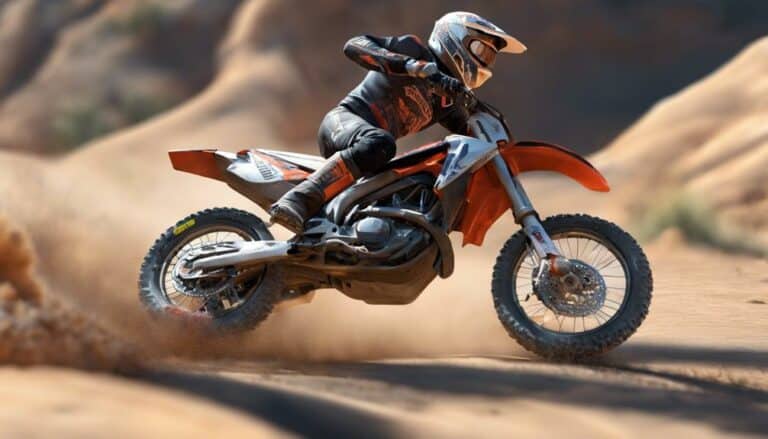When cornering on trails, did you know that proper body positioning can increase your control and confidence by up to 40%? Mastering the art of maneuvering through corners is essential for off-road riders seeking to enhance their skills.
By understanding the significance of foot placement, hip alignment, shoulder movements, elbow flexibility, and head positioning, you can reveal the secret to smoother and more controlled cornering experiences.
So, let's explore the intricacies of each element and how they collectively contribute to your success on the trails.
Key Takeaways
- Maintain outside foot on peg, inside foot slightly off for balance and quick adjustments.
- Adapt hip position for traction and balance on varying terrain during cornering.
- Coordinate shoulder movement with hips for balanced turns and weight distribution.
- Keep head aligned with shoulders for better vision, reduced fatigue, and improved trail scanning.
Proper Foot Placement for Cornering
When cornering off-road, consistently position your outside foot on the footpeg to effectively support your body weight and maintain balance. Placing your foot on the outside peg allows you to anchor yourself to the bike, giving you better control and stability while maneuvering through trail corners. By using the ball of your foot on the footpeg, you can maximize leverage and maneuver the bike with precision.
Proper foot placement is important for weight shifts during cornering. Keeping your inside foot slightly off the footpeg enables you to adjust your body position quickly, aiding in maintaining balance through the corners. Avoid placing your feet too far forward on the footpegs to prevent interference with the bike's controls, ensuring a smooth and controlled ride.
Importance of Hip Positioning in Corners
To optimize your performance and control while negotiating corners on off-road trails, mastering proper hip positioning is key for influencing bike trajectory and maintaining balance. Your hip positioning plays an important role in ensuring that your body weight is distributed effectively to enhance control and stability while cornering.
By shifting your hips forward during hill climbs, you can improve traction and control in corners, allowing you to maneuver more confidently. Conversely, adjusting your hips rearward during hill descents enhances balance and stability, enabling smoother turns.
Additionally, adjusting your hip movement according to the terrain, such as rocky or rutted paths, is essential for maintaining control while cornering. Since approximately 60% of your body weight lies above the hips, the significance of hip positioning for overall balance and control on off-road trails can't be overstated.
Utilizing Shoulder Movement for Control
Utilizing shoulder movement effectively enhances control and stability while cornering on off-road trails, aiding in counterbalancing the bike for best maneuverability.
When syncing your shoulder movement with your hips, you actively contribute to the bike's balance, allowing for smoother turns and improved lean angles specifically tailored for off-road riding.
The coordination of shoulder positioning with hip movements is important for adjusting weight distribution, ultimately leading to better control and stability when handling corners on challenging trails.
Correct shoulder alignment prevents a compressed body posture that could compromise your handling and overall stability while riding off-road.
By mastering the art of shifting your shoulders in harmony with your hips, you optimize your ability to handle the bike with finesse and precision, ensuring a safer and more enjoyable riding experience on diverse off-road terrains.
Enhancing Balance Through Elbow Flexibility
Enhancing balance through flexible elbows is important for absorbing off-road terrain and maintaining cornering stability. When riding off-road, your elbow flexibility plays a vital role in your overall body positioning and control on the trail.
Here's how you can improve your balance through elbow flexibility:
- Maintain a Bend: Avoid locking your elbows to allow for better absorption of rough terrain and to enhance your maneuverability.
- Proper Positioning: Keep a slight bend in your elbows, aiming for approximately 90° angles at the elbow and shoulder. This position optimizes your input and control while riding.
- Utilize Inside Elbow: When counterbalancing during cornering, extend your inside elbow slightly to improve your balance and control through the lean angle.
Head Alignment for Precise Trail Cornering
For precise trail cornering, make sure your head remains aligned with your shoulders to enhance vision, balance, and control. Keeping your head up and in line with your shoulders not only improves your ability to see the trail ahead but also helps maintain your balance while steering corners.
Proper head alignment reduces neck fatigue and allows for better scanning of the terrain, giving you more time to react to obstacles or changes in the trail. Additionally, your head position greatly influences your overall body posture, contributing to stability and control as you lean into corners.
Conclusion
To sum up, mastering proper body positioning while cornering on off-road trails is essential for control and balance. By maintaining a slight bend in your elbows, syncing your shoulders and hips, and aligning your head over your shoulders, you can greatly improve your cornering technique.
For example, professional off-road rider, Sarah, saw a noticeable improvement in her trail performance after focusing on these key techniques.
Practice and consistency are key to becoming a skilled off-road rider.

